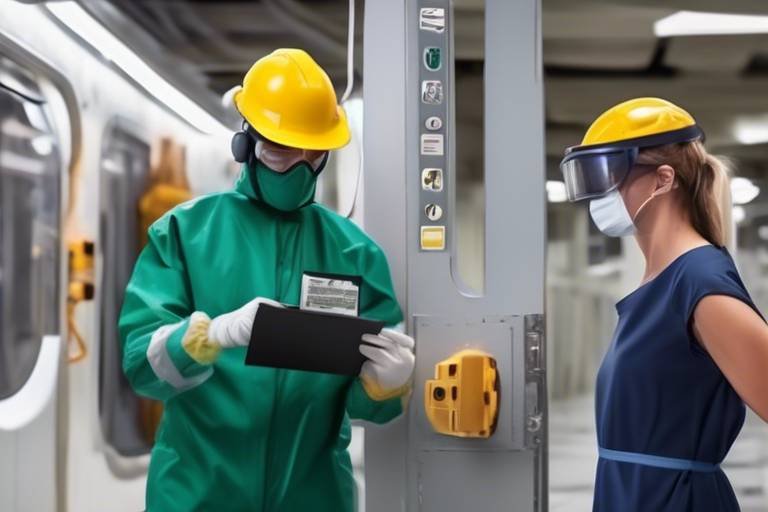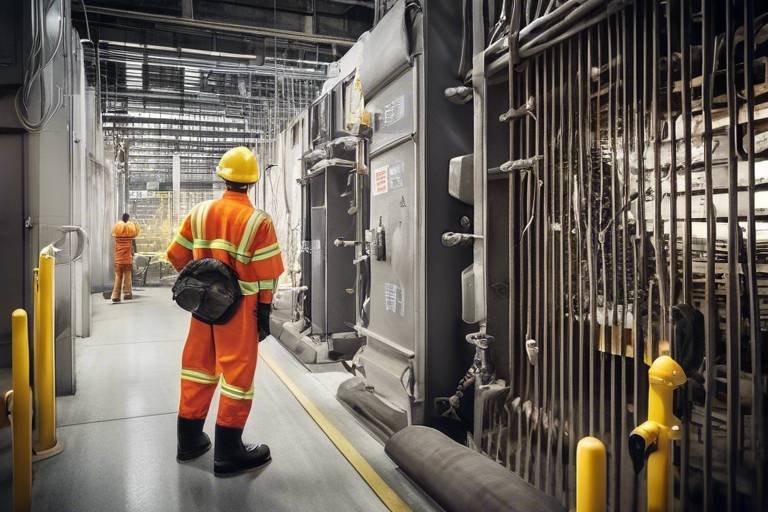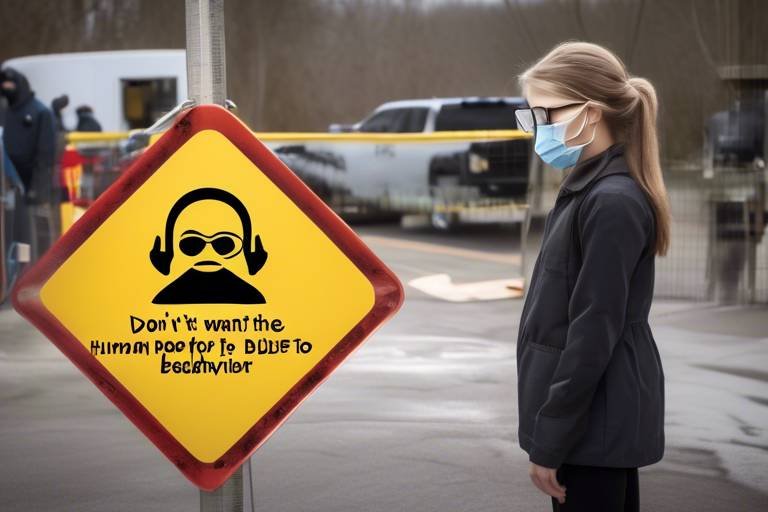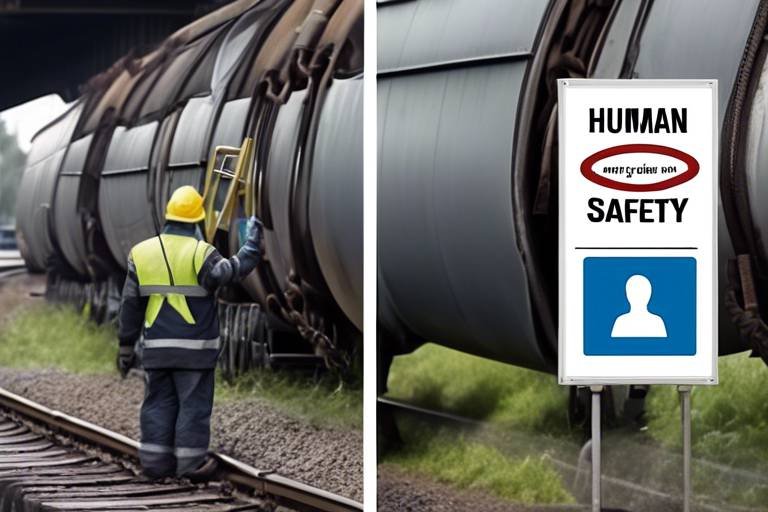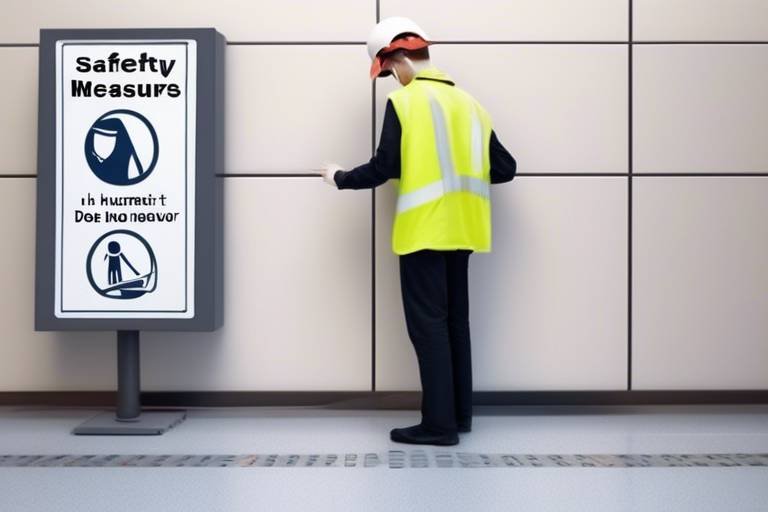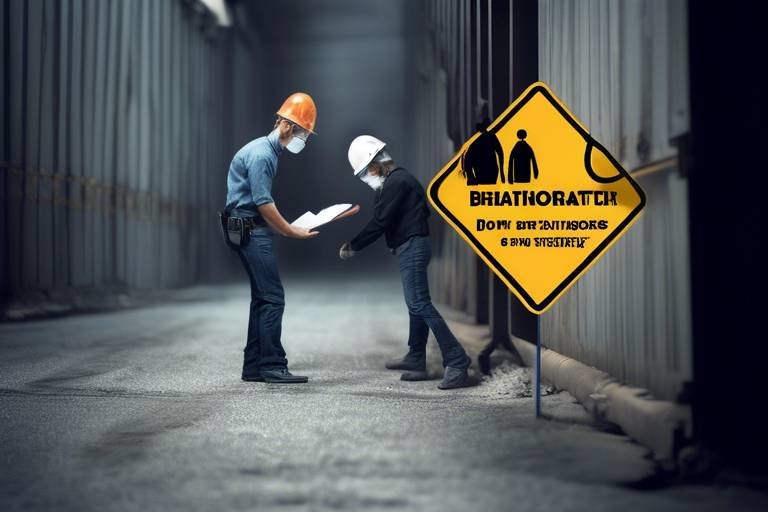Understanding the Role of Human Behavior in Safety Protocols
When we think about safety protocols, the first thing that often comes to mind is a list of rules and regulations that must be followed. However, what many people overlook is the crucial role that human behavior plays in the effectiveness of these protocols. It's not just about having the right guidelines in place; it's about how individuals perceive, understand, and act upon these guidelines in their daily routines. In essence, the success of safety protocols is deeply intertwined with the actions and attitudes of the people who are supposed to follow them.
Imagine a workplace where safety protocols are rigidly enforced, yet employees consistently disregard them. This scenario highlights a significant gap between policy and practice, driven by human behavior. Factors such as motivation, risk perception, and the organizational culture can greatly influence whether individuals choose to comply with safety measures or not. For instance, if employees feel that their safety is not prioritized, they may become disengaged, leading to a culture where safety protocols are seen as mere formalities rather than essential practices.
Understanding the psychology behind safety compliance is like peeling an onion; each layer reveals deeper insights into what drives behavior. Are employees motivated by fear of consequences, or do they genuinely care about their own safety and that of their colleagues? The answer to this question can shape the approach organizations take towards safety training and compliance. A workplace that fosters a positive safety culture, where employees feel valued and heard, is more likely to experience higher levels of compliance with safety protocols.
Moreover, the perception of risk plays a pivotal role in how safety protocols are viewed. If employees underestimate the dangers associated with their tasks, they may be less inclined to adhere to safety measures. Therefore, it becomes imperative for organizations to not only educate their workforce about the risks involved but also to create an environment where safety is a shared responsibility. This can be achieved through open communication and by encouraging employees to actively participate in safety discussions and initiatives.
In conclusion, the role of human behavior in safety protocols is multifaceted and cannot be ignored. By focusing on the psychological aspects of compliance, organizations can develop more effective safety strategies that resonate with their employees. After all, safety is not just about rules; it's about creating a culture where every individual feels responsible for their own safety and the safety of others. This shift in perspective can lead to significant improvements in safety outcomes across various environments.
- What is the importance of human behavior in safety protocols?
Human behavior directly impacts the effectiveness of safety protocols. Understanding how employees perceive risk and their motivations for compliance can lead to better safety practices. - How can organizations improve safety compliance?
Organizations can improve safety compliance by fostering a positive safety culture, providing effective training, and ensuring clear communication regarding safety protocols. - What role does leadership play in safety culture?
Leadership is crucial in shaping safety culture. Leaders set the tone for safety practices and can influence employee behavior through their actions and commitment to safety. - How can technology enhance safety communication?
Technology can facilitate real-time sharing of safety information, making it easier for employees to stay informed about protocols and updates.

The Psychology of Safety Compliance
Understanding the psychological factors that drive safety compliance is crucial for any organization aiming to foster a culture of safety. At the heart of this understanding lies the concept of motivation. What motivates employees to follow safety protocols? Is it fear of punishment, a desire to keep their colleagues safe, or perhaps a personal commitment to their own well-being? Each individual's motivation can vary significantly based on their personal experiences and perceptions of risk.
Speaking of risk perception, this plays a pivotal role in how employees view safety protocols. If an employee perceives a task as low-risk, they might be less inclined to follow safety measures. Conversely, if they recognize a high risk, they may become overly cautious, potentially leading to unnecessary delays. This perception is often shaped by previous experiences, training, and the overall organizational culture. A culture that prioritizes safety will likely lead to heightened awareness and compliance among employees.
Moreover, the impact of organizational culture cannot be understated. A workplace that openly communicates the importance of safety and encourages employees to voice their concerns will naturally cultivate a more compliant workforce. For instance, consider a scenario where employees feel comfortable reporting unsafe conditions without fear of retribution. This openness fosters trust and encourages individuals to adhere to safety protocols, knowing that their input is valued.
To illustrate this point further, let's look at a simple table that summarizes the key psychological factors influencing safety compliance:
| Factor | Influence on Compliance |
|---|---|
| Motivation | Drives adherence to safety measures based on personal and organizational values. |
| Risk Perception | Affects how seriously employees take safety protocols based on their perceived threat level. |
| Organizational Culture | Shapes attitudes towards safety and encourages open communication about safety concerns. |
In conclusion, the psychology of safety compliance is a complex interplay of various factors. By understanding what motivates employees, how they perceive risk, and the influence of organizational culture, companies can create a more effective safety environment. It's not just about having protocols in place; it's about ensuring that employees are psychologically equipped to follow them. After all, safety is not just a set of rules to follow; it's a mindset that must be cultivated.
- What is the role of motivation in safety compliance? Motivation influences how seriously employees take safety protocols, impacting their willingness to comply.
- How does risk perception affect safety behavior? Employees who perceive a task as low-risk may be less likely to follow safety measures, while those who recognize high risks may adhere more strictly to protocols.
- Why is organizational culture important for safety compliance? A positive organizational culture encourages open communication about safety, fostering trust and compliance among employees.

Training and Education Strategies
When it comes to promoting safety in the workplace, effective training programs are not just a nice-to-have; they are a must-have. Think of training as the foundation of a house—without it, everything else is at risk of collapsing. It's all about ensuring that every employee understands not only the importance of safety protocols but also how to implement them in their daily tasks. But how do we make training engaging and memorable? That’s the million-dollar question!
First off, it’s essential to recognize that people learn in different ways. Some might be visual learners, while others prefer hands-on experiences or auditory instruction. Therefore, a one-size-fits-all approach to training can fall flat. Instead, organizations should consider a multifaceted training strategy that incorporates various methods, such as:
- Interactive Workshops: These allow employees to engage actively with the material, ask questions, and practice skills in a controlled environment.
- Online Modules: E-learning platforms can provide flexibility, allowing employees to learn at their own pace while still covering essential safety topics.
- Simulation Exercises: These can recreate real-life scenarios, enabling employees to apply their knowledge in a safe setting.
Moreover, it’s not just about delivering information; it’s about ensuring that employees retain what they learn. To enhance retention, organizations can implement strategies such as:
- Regular Refresher Courses: These can help reinforce knowledge and keep safety protocols fresh in employees' minds.
- Peer-to-Peer Training: Encouraging employees to teach each other can foster a deeper understanding and create a sense of community around safety.
- Gamification: Incorporating game-like elements into training can make learning fun and engaging, motivating employees to participate actively.
Another critical aspect is to ensure that training is not a one-off event but an ongoing process. Just like exercising, maintaining safety knowledge requires regular practice and reinforcement. Organizations should create a culture where continuous learning is valued. This means providing opportunities for employees to share their experiences, discuss challenges, and learn from one another.
In addition to traditional training methods, leveraging technology can also play a significant role in enhancing safety education. For instance, using virtual reality (VR) can immerse employees in realistic safety scenarios, allowing them to practice responses without the risks associated with real-life situations. This innovative approach not only makes training more engaging but also significantly improves knowledge retention.
Lastly, let’s not forget about the importance of feedback. After training sessions, organizations should actively seek feedback from participants to understand what worked well and what didn’t. This feedback loop is crucial for refining training programs and ensuring they meet the needs of employees effectively. By involving employees in the process, organizations can create a sense of ownership over safety protocols, which can lead to higher compliance rates.
Q1: Why is training important for safety compliance?
A1: Training is essential because it equips employees with the knowledge and skills necessary to follow safety protocols effectively, reducing the risk of accidents and injuries.
Q2: How often should safety training be conducted?
A2: Safety training should be conducted regularly, with refresher courses at least once a year, and more frequently if new protocols or equipment are introduced.
Q3: What methods can enhance the effectiveness of safety training?
A3: Interactive workshops, online modules, simulation exercises, and gamification are effective methods that cater to different learning styles and enhance engagement.
Q4: How can technology be used in safety training?
A4: Technology such as virtual reality can simulate real-life scenarios, making training immersive and engaging, which significantly improves retention of safety knowledge.
Q5: What role does feedback play in safety training?
A5: Feedback helps organizations refine their training programs, ensuring they are effective and meet the needs of employees, ultimately leading to better safety compliance.

Behavioral-Based Safety Programs
Behavioral-Based Safety (BBS) Programs are designed to address the human element of safety in the workplace. At their core, these programs focus on identifying and modifying unsafe behaviors that can lead to accidents and injuries. Think about it: if we can change how people act, we can significantly reduce the risks associated with their actions. It's like teaching someone to drive safely; you don’t just tell them the rules of the road—you show them how to apply those rules in real life.
Implementing a BBS program involves several key principles that guide its effectiveness. First and foremost, it relies on the observation of behaviors in real-time. Safety professionals or trained peers watch how employees perform their tasks, noting both safe and unsafe practices. This isn’t about policing; rather, it’s an opportunity to provide constructive feedback that encourages safe habits. Imagine a coach watching their players, not to criticize, but to help them improve their game. This approach fosters a supportive environment where everyone can learn from one another.
One of the standout features of BBS programs is their emphasis on **engagement**. Employees are not just passive recipients of safety information; they are active participants in the process. This can be achieved through regular safety meetings where team members share observations and discuss potential hazards. By involving employees in safety discussions, organizations can cultivate a sense of ownership over their own safety practices. When people feel responsible for their actions, they are more likely to adhere to safety protocols.
To illustrate the effectiveness of BBS programs, consider the following table that compares incident rates before and after the implementation of such a program:
| Year | Incident Rate (per 100 employees) | Notes |
|---|---|---|
| 2019 | 12 | Baseline data collected |
| 2020 | 8 | Initial BBS program implemented |
| 2021 | 4 | Ongoing improvements and feedback integrated |
As you can see, the incident rate dropped dramatically from 12 to 4 incidents per 100 employees over two years. This significant reduction highlights the impact that a well-structured BBS program can have on workplace safety. However, it’s essential to recognize that the success of these programs isn’t solely based on numbers; it’s also about changing attitudes and building a culture of safety.
Another critical aspect of BBS programs is the use of **positive reinforcement**. When employees demonstrate safe behaviors, they should be recognized and rewarded. This could be as simple as verbal praise or as formal as a safety awards program. The idea is to create a feedback loop where safe actions are acknowledged, thereby encouraging more of the same. It’s akin to training a pet: when they do something right, you reward them, and they’re more likely to repeat that behavior.
In conclusion, Behavioral-Based Safety Programs are not just about enforcing rules; they are about understanding and influencing human behavior. By focusing on observation, engagement, and positive reinforcement, organizations can create safer workplaces. The journey towards a culture of safety may take time and effort, but the results—reduced incidents, improved morale, and a stronger safety culture—are well worth it.
- What is a Behavioral-Based Safety Program?
A BBS program focuses on identifying and modifying unsafe behaviors in the workplace to enhance safety. - How do BBS programs improve safety?
They promote engagement, provide real-time feedback, and encourage positive behaviors among employees. - Can BBS programs reduce incident rates?
Yes, many organizations have reported significant reductions in incident rates after implementing BBS programs. - What role does positive reinforcement play in BBS?
Positive reinforcement helps motivate employees to adhere to safety protocols by rewarding safe behaviors.

Observational Techniques
Observational techniques are essential tools in the realm of safety protocols, serving as a bridge between theory and practice. These methods allow organizations to identify unsafe behaviors in real-time, providing invaluable insights into how employees interact with their work environment. By observing behaviors, safety managers can pinpoint areas that require immediate attention and improvement. But how exactly do we implement these techniques effectively? Let’s break it down.
First off, it’s important to establish a clear framework for observation. This involves defining what constitutes safe and unsafe behavior within the context of your specific workplace. For instance, in a manufacturing setting, safe behaviors might include wearing protective gear and following machinery protocols, while unsafe behaviors could involve neglecting these practices. Observers should be trained to recognize these behaviors consistently, ensuring that safety assessments are objective and reliable.
Next, the method of observation itself is crucial. There are several approaches that can be employed, including:
- Direct Observation: This involves watching employees perform their tasks in real-time. Observers take notes on both safe and unsafe practices, providing a comprehensive view of the workplace dynamics.
- Peer Observations: Encouraging employees to observe one another can foster a culture of accountability. This method not only enhances safety but also builds camaraderie among team members as they work together towards a common goal.
- Video Observations: Utilizing technology to record workplace activities allows for detailed analysis. This method can be particularly effective for training purposes, as it provides concrete examples of both safe and unsafe behaviors.
After conducting observations, the next step is to provide constructive feedback. This feedback should not be punitive but rather aimed at promoting safe practices. For example, if an observer notices that an employee frequently forgets to wear safety goggles, the feedback could focus on the importance of eye protection and the potential risks involved. This approach not only corrects the behavior but also educates the employee on the underlying reasons for the safety protocol.
Moreover, it's vital to create a culture where feedback is welcomed and encouraged. Employees should feel safe to discuss their observations without fear of retribution. This open communication channel can lead to greater engagement and compliance with safety protocols. To facilitate this, regular meetings can be held where employees can share their observations and suggestions for improvement, fostering a collaborative approach to workplace safety.
Finally, it’s essential to track the effectiveness of observational techniques over time. By analyzing trends in safety incidents before and after implementing observation strategies, organizations can gauge their impact. This data not only helps in refining the observational methods used but also serves as a motivational tool, showcasing the positive changes that arise from diligent observation and feedback.
In summary, observational techniques are a powerful means of enhancing safety protocols within any organization. By systematically observing behaviors, providing constructive feedback, and fostering a culture of open communication, organizations can significantly reduce the risk of accidents and injuries in the workplace. Remember, safety is not just about compliance; it’s about creating an environment where everyone feels responsible for their own safety and that of their colleagues.
Q1: What are observational techniques in safety protocols?
Observational techniques involve watching and analyzing employee behaviors to identify safe and unsafe practices within the workplace. This helps in enhancing safety measures and compliance.
Q2: How can feedback from observations be effectively communicated?
Feedback should be constructive and focused on promoting safety. It’s important to approach employees with respect and provide clear examples of both safe and unsafe behaviors.
Q3: Can technology aid in observational techniques?
Yes, technology can play a significant role through methods like video observations, which allow for detailed analysis and training based on real-life scenarios.
Q4: Why is it important to create a culture of open communication regarding safety?
A culture of open communication encourages employees to share their observations and concerns without fear, leading to improved safety practices and a more engaged workforce.

Positive Reinforcement Methods
When it comes to promoting safety in the workplace, positive reinforcement can be a game changer. Instead of merely focusing on what employees do wrong, why not highlight what they do right? This approach not only boosts morale but also creates a more engaged workforce. Think of it like watering a plant; when you give it the right nutrients and care, it flourishes. Similarly, when employees receive recognition for their safe behaviors, they are more likely to continue those behaviors.
One effective method of positive reinforcement is through reward systems. These can take various forms, such as:
- Monetary bonuses for teams that achieve safety milestones.
- Public recognition during meetings or through company newsletters.
- Gift vouchers for employees who consistently follow safety protocols.
Moreover, creating a “safety champion” program can empower employees. By selecting individuals who exemplify safe practices, organizations can encourage others to follow suit. These champions can serve as role models, demonstrating that safety is not just a requirement but a shared value. It's like having a buddy system where everyone looks out for each other, fostering a culture of safety.
Another impactful method is utilizing gamification. By turning safety practices into a game, employees can earn points or badges for adhering to safety protocols. This not only makes compliance fun but also instills a sense of achievement. Imagine a leaderboard displaying the top safety performers; it creates a friendly competition that motivates everyone to step up their game. Gamification can include:
- Safety quizzes with rewards for high scores.
- Challenges that encourage teamwork in identifying hazards.
- Monthly safety contests with prizes for the safest department.
Furthermore, incorporating feedback loops into your positive reinforcement strategy can amplify its effectiveness. When employees are acknowledged for their safe behaviors, they should also receive constructive feedback on how to improve further. This two-way communication not only reinforces positive actions but also opens the door for continuous learning.
In summary, positive reinforcement methods are essential for cultivating a culture of safety in the workplace. By recognizing and rewarding safe behaviors, organizations can motivate employees to prioritize safety, ultimately leading to fewer incidents and a healthier work environment. After all, when employees feel valued and appreciated, they are more likely to embrace safety as a core aspect of their work ethic.
Q: What is positive reinforcement in the context of workplace safety?
A: Positive reinforcement involves recognizing and rewarding safe behaviors to encourage employees to continue following safety protocols.
Q: How can I implement a reward system for safety compliance?
A: You can create a reward system by offering monetary bonuses, public recognition, or gift vouchers for employees who consistently adhere to safety practices.
Q: What is gamification, and how does it relate to safety?
A: Gamification involves applying game-like elements to non-game contexts, such as safety practices. It can include earning points or badges for safe behaviors, making compliance more engaging.
Q: Why is feedback important in a positive reinforcement strategy?
A: Feedback helps employees understand their strengths and areas for improvement, reinforcing positive behaviors and promoting continuous learning in safety practices.

Role of Leadership in Safety Culture
Leadership plays a pivotal role in shaping the safety culture within any organization. When leaders actively engage in safety practices, they set a powerful example for their teams. Imagine a ship navigating through stormy seas; the captain's steady hand and clear vision are crucial for the crew's safety. Similarly, in a workplace, leaders who prioritize safety create an environment where employees feel secure and valued. This not only boosts morale but also enhances overall productivity.
One of the key responsibilities of leaders is to communicate the importance of safety effectively. This involves not just verbal communication but also embodying safety in every action. Leaders should regularly participate in safety meetings, conduct training sessions, and be visible in their commitment to safety protocols. When employees see their leaders adhering to safety measures, it reinforces the message that safety is a shared responsibility. It's like a coach who not only instructs players but also demonstrates techniques on the field.
Moreover, leaders must foster an inclusive safety culture, where every employee feels empowered to voice their concerns and suggestions. This can be achieved through open-door policies and regular feedback sessions. Just as a gardener nurtures each plant to help it thrive, leaders should cultivate an environment where employees feel safe to express their thoughts. By encouraging dialogue, leaders can uncover potential hazards and address them proactively, creating a more resilient organization.
Another essential aspect is the establishment of clear safety goals and expectations. Leaders should ensure that safety protocols are not just written documents but are integrated into the daily operations of the workplace. This can be done by setting measurable objectives, such as reducing incident rates or increasing safety training participation. Tracking progress towards these goals can be akin to a sports team monitoring their performance stats; it keeps everyone focused and accountable.
| Leadership Actions | Impact on Safety Culture |
|---|---|
| Participating in safety training | Demonstrates commitment and sets an example |
| Encouraging employee feedback | Builds trust and uncovers safety issues |
| Setting measurable safety goals | Enhances accountability and focus |
In conclusion, the role of leadership in safety culture cannot be overstated. Leaders who prioritize safety not only protect their employees but also foster a culture of trust and collaboration. By actively engaging in safety practices, communicating effectively, and encouraging open dialogue, leaders can significantly enhance safety outcomes within their organizations. After all, a strong safety culture is like a well-oiled machine, where every part works together to ensure smooth and safe operations.
- What is the role of leadership in promoting safety? Leaders are responsible for setting the tone for safety culture, communicating expectations, and modeling safe behavior.
- How can leaders encourage employee participation in safety initiatives? By fostering an open environment where employees feel comfortable sharing their concerns and suggestions.
- What are some effective ways to communicate safety protocols? Regular meetings, training sessions, and visible commitment to safety practices help reinforce safety messages.

Communication and Safety Protocols
When it comes to safety protocols, effective communication is not just a nice-to-have; it's a necessity. Imagine trying to navigate a maze blindfolded—without clear directions, you're bound to hit a wall. Similarly, in workplaces where safety protocols are in place, clear communication ensures that everyone is on the same page, minimizing the risk of accidents and injuries. The importance of communication in safety protocols cannot be overstated, as it encompasses everything from understanding the protocols themselves to knowing how to report incidents or hazards.
One of the key aspects of effective communication is ensuring that all employees understand their roles and responsibilities when it comes to safety. This means that safety protocols must be communicated in a way that is not only clear but also engaging. Utilizing various methods such as meetings, training sessions, and visual aids can significantly enhance the understanding of safety procedures among employees. For instance, consider the use of infographics that outline safety steps visually—these can be far more impactful than a lengthy document filled with jargon.
Moreover, fostering an open line of communication encourages employees to voice their concerns about safety protocols. When workers feel comfortable sharing their thoughts, it creates a culture where safety is prioritized. This can be achieved through regular feedback mechanisms, such as surveys or suggestion boxes, where employees can express their views without fear of retribution. By actively seeking feedback, organizations can identify areas for improvement and adjust safety protocols accordingly.
In addition to traditional communication methods, technology plays a crucial role in enhancing safety communication. For example, utilizing mobile applications or digital platforms can facilitate real-time sharing of safety information and updates among employees. Imagine a scenario where an employee notices a potential hazard; with the right technology, they can instantly report it, and everyone in the vicinity is notified immediately. This not only improves response times but also reinforces the idea that safety is a collective responsibility.
To illustrate the impact of effective communication on safety protocols, consider this table that outlines common communication methods and their benefits:
| Communication Method | Benefits |
|---|---|
| Meetings | Facilitates group discussions and clarifies doubts. |
| Training Sessions | Provides hands-on experience and reinforces learning. |
| Visual Aids | Makes complex information easier to understand. |
| Technology Platforms | Enables real-time updates and faster communication. |
Ultimately, the goal of improving communication around safety protocols is to create an environment where safety is everyone's responsibility. By ensuring that each employee understands their role and feels empowered to communicate openly, organizations can significantly reduce the likelihood of accidents. Remember, safety isn't just about following rules; it's about fostering a culture where everyone is actively engaged in promoting a safe workplace.
- Why is communication critical in safety protocols?
Communication ensures that all employees understand safety procedures, minimizing the risk of accidents. - How can technology enhance safety communication?
Technology allows for real-time sharing of safety information, making it easier for employees to report hazards immediately. - What role does feedback play in safety communication?
Feedback mechanisms encourage employees to voice their concerns, helping organizations identify areas for improvement.

Utilizing Technology for Safety Communication
In today's fast-paced world, technology plays a critical role in enhancing safety communication within organizations. With the rise of digital tools and platforms, companies have more opportunities than ever to ensure that safety protocols are communicated clearly and effectively. Imagine a workplace where employees can instantly receive updates about safety procedures or potential hazards—this is not just a dream, but a reality made possible by technology.
One of the most effective ways to utilize technology for safety communication is through the implementation of mobile applications. These apps can serve as a centralized hub for safety information, allowing employees to access guidelines, report incidents, and receive alerts in real time. For instance, a construction site might use an app that notifies workers about weather conditions or equipment malfunctions, ensuring that everyone is on the same page and can take necessary precautions.
Moreover, cloud-based platforms can facilitate seamless communication across teams. By storing safety documents and protocols in the cloud, organizations enable employees to access vital information from anywhere, at any time. This not only enhances accessibility but also fosters a culture of transparency and accountability. Employees are more likely to adhere to safety protocols when they have easy access to the information they need.
Additionally, integrating video conferencing tools into safety meetings can significantly improve participation and engagement. Instead of traditional, often tedious, in-person meetings, virtual meetings allow for interactive discussions where employees can ask questions and share experiences. This dynamic approach not only makes safety training more enjoyable but also reinforces the importance of safety in a real-world context.
Furthermore, utilizing social media platforms can also enhance safety communication. Companies can create private groups or forums where employees can share safety tips, report unsafe conditions, or discuss best practices. This peer-to-peer communication encourages a sense of community and shared responsibility for safety, reinforcing the idea that everyone plays a role in maintaining a safe work environment.
To illustrate the effectiveness of technology in safety communication, consider the following table that outlines various tools and their benefits:
| Technology Tool | Benefits |
|---|---|
| Mobile Applications | Real-time updates, incident reporting, easy access to safety guidelines |
| Cloud-Based Platforms | Accessibility, transparency, centralized information storage |
| Video Conferencing | Interactive training, increased engagement, flexibility in scheduling |
| Social Media Groups | Peer support, sharing best practices, fostering community |
In conclusion, leveraging technology for safety communication is not just a trend; it is a necessity in today's work environments. By adopting these digital tools, organizations can bridge the gap in communication, enhance compliance with safety protocols, and ultimately create a safer workplace for everyone. Embracing technology is like equipping your team with a powerful set of tools that can help them navigate the complexities of safety in a modern world.
- How can mobile apps improve safety communication? Mobile apps provide real-time updates and easy access to safety protocols, making it simpler for employees to stay informed and report incidents.
- What role does cloud technology play in safety? Cloud technology allows for centralized storage of safety documents, ensuring that all employees can access necessary information from anywhere.
- Why are video conferences effective for safety training? Video conferences foster interactive discussions, making safety training more engaging and allowing for immediate feedback.
- Can social media enhance safety culture? Yes, social media platforms can create a sense of community among employees, encouraging them to share safety tips and best practices.

Feedback Mechanisms
Feedback mechanisms are essential components in the realm of safety protocols, acting as a bridge between employees and management. They create a two-way street where concerns can be voiced, and solutions can be collaboratively developed. Imagine a bustling workplace where every employee feels empowered to share their insights and experiences related to safety. This not only fosters a sense of belonging but also enhances the overall safety culture within the organization.
One effective method of implementing feedback mechanisms is through regular safety meetings. These gatherings provide an open forum for employees to discuss safety issues, share suggestions, and celebrate successes. By encouraging participation, organizations can tap into the collective wisdom of their workforce. But what happens when feedback is given? It’s crucial that management acknowledges and acts on the input received. When employees see their suggestions being taken seriously, it reinforces their commitment to safety.
Additionally, anonymous feedback tools, such as suggestion boxes or digital platforms, can be incredibly effective. These tools allow employees to express concerns without fear of reprisal, leading to a more honest and open dialogue about safety practices. The anonymity factor can often reveal issues that might not surface in open discussions, as employees may feel more comfortable sharing their thoughts without being identified.
To illustrate the impact of feedback mechanisms, consider the following table that outlines the benefits of implementing such systems:
| Benefit | Description |
|---|---|
| Enhanced Communication | Encourages open dialogue between employees and management, leading to a stronger safety culture. |
| Increased Employee Engagement | Involving employees in safety discussions fosters a sense of ownership and responsibility. |
| Identification of Issues | Anonymous feedback can uncover hidden hazards and concerns that may not be reported otherwise. |
| Continuous Improvement | Regular feedback loops allow for ongoing assessment and refinement of safety protocols. |
Moreover, feedback mechanisms can also include surveys and questionnaires that gauge employee perceptions of safety protocols. These tools can be designed to assess various aspects, such as the clarity of safety procedures, the adequacy of training, and overall workplace safety culture. When results are analyzed, organizations can pinpoint areas needing improvement and act accordingly.
In conclusion, establishing robust feedback mechanisms is not just a checkbox on a compliance list; it is a vital strategy for enhancing safety outcomes. By creating an environment where employees feel heard and valued, organizations can significantly reduce risks and improve overall safety performance. So, why not take the first step today? Start fostering that culture of feedback and watch as your workplace transforms into a safer, more collaborative environment.
- What are feedback mechanisms in safety protocols?
Feedback mechanisms are systems that allow employees to provide input on safety practices, helping to identify issues and improve overall safety culture. - How can I encourage employees to give feedback?
Creating a safe environment for open communication, offering anonymous feedback options, and actively responding to suggestions can encourage employees to share their thoughts. - What role does management play in feedback mechanisms?
Management is responsible for fostering a culture of safety, actively seeking feedback, and implementing changes based on employee input. - Are anonymous feedback tools effective?
Yes, anonymous feedback tools can help uncover issues that employees may hesitate to share openly, leading to more honest feedback.
Frequently Asked Questions
- What is the importance of understanding human behavior in safety protocols?
Understanding human behavior is crucial because it directly influences how individuals adhere to safety protocols. When organizations recognize the psychological factors that drive compliance, they can tailor their training and communication strategies to better motivate employees, ultimately leading to a safer work environment.
- How can training programs enhance safety compliance?
Effective training programs are designed to engage employees and ensure they understand the safety protocols. By incorporating hands-on activities, real-life scenarios, and interactive elements, these programs can significantly enhance retention and application of safety measures, making compliance more likely.
- What are behavioral-based safety programs?
Behavioral-based safety programs focus on changing employee behaviors to promote a safer workplace. These programs use observations and feedback to encourage safe practices, helping to reduce incidents by fostering a culture of accountability and awareness among workers.
- How do observational techniques contribute to safety?
Observational techniques allow supervisors and peers to identify unsafe behaviors in real-time. By providing constructive feedback based on these observations, organizations can help employees correct unsafe practices and reinforce positive behaviors, thereby enhancing overall safety.
- What role does leadership play in promoting a safety culture?
Leadership is pivotal in shaping the safety culture of an organization. Leaders set the tone for safety by modeling safe behaviors, communicating the importance of safety protocols, and actively engaging with employees to foster a shared commitment to maintaining a safe workplace.
- Why is clear communication essential for safety protocols?
Clear communication ensures that all employees understand their roles and responsibilities regarding safety. It minimizes misunderstandings and reinforces the importance of adhering to protocols, which can significantly reduce the risk of accidents and injuries in the workplace.
- How can technology enhance safety communication?
Technology can streamline safety communication by providing tools and platforms for real-time sharing of safety information. This can include mobile apps, instant messaging systems, and digital dashboards that keep employees informed about safety updates, procedures, and alerts.
- What are the benefits of implementing feedback mechanisms?
Feedback mechanisms empower employees to voice their concerns and suggestions regarding safety protocols. This open line of communication helps identify areas for improvement and fosters a culture of safety where everyone feels responsible for maintaining a safe work environment.

